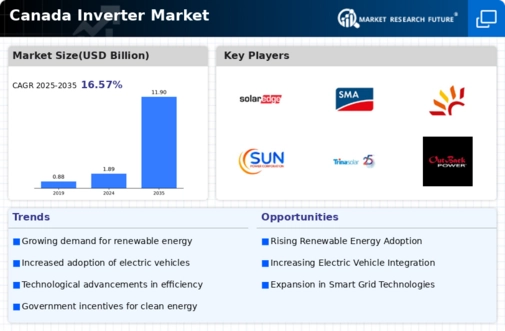Expansion of Smart Grid Technologies
The development of smart grid technologies in Canada is significantly influencing the inverter market. Smart grids facilitate the efficient distribution of electricity, integrating renewable energy sources and enhancing grid reliability. As of 2025, investments in smart grid infrastructure are expected to reach $5 billion, creating a robust demand for advanced inverters that can manage distributed energy resources. These inverters play a crucial role in optimizing energy flow and ensuring grid stability. Consequently, the inverter market is likely to experience a growth rate of approximately 12% as utilities and consumers increasingly adopt smart grid solutions.
Integration of Energy Storage Systems
The integration of energy storage systems in Canada is emerging as a key driver for the inverter market. As more households and businesses invest in battery storage solutions, the need for compatible inverters is increasing. In 2025, the energy storage market is projected to grow by 20%, creating a substantial opportunity for inverter manufacturers. These inverters are essential for managing the flow of energy between storage systems and the grid, ensuring optimal performance. The inverter market is likely to benefit from this trend, as consumers seek to maximize the utility of their energy storage investments, leading to a projected growth rate of 14%.
Focus on Sustainable Building Practices
The emphasis on sustainable building practices in Canada is significantly impacting the inverter market. As construction standards evolve to prioritize energy efficiency and sustainability, the demand for inverters that support renewable energy systems is increasing. By 2025, it is anticipated that 30% of new buildings will incorporate solar energy solutions, necessitating advanced inverter technologies. This shift towards green building practices is likely to drive a growth rate of 11% in the inverter market, as builders and developers seek to comply with environmental regulations and meet consumer demand for sustainable living options.
Increasing Adoption of Electric Vehicles
The surge in electric vehicle (EV) adoption in Canada is driving the inverter market. As more consumers transition to EVs, the demand for efficient charging solutions rises, necessitating advanced inverters. In 2025, it is estimated that the number of EVs on Canadian roads will exceed 1 million, leading to a projected growth of 15% in the inverter market. This growth is attributed to the need for inverters that can handle the unique power requirements of EV charging stations. Furthermore, the integration of renewable energy sources with EV charging infrastructure is likely to enhance the inverter market, as consumers seek sustainable energy solutions.
Rising Energy Costs and Efficiency Needs
The escalating energy costs in Canada are prompting consumers and businesses to seek more efficient energy solutions, thereby impacting the inverter market. With energy prices projected to rise by 8% in the next year, there is a growing emphasis on energy efficiency and cost savings. Inverters that enhance energy conversion efficiency are becoming essential for both residential and commercial applications. This trend is likely to drive a 10% increase in the inverter market as consumers invest in technologies that reduce their energy bills. The focus on energy efficiency aligns with broader sustainability goals, further propelling the demand for advanced inverter solutions.






















Leave a Comment